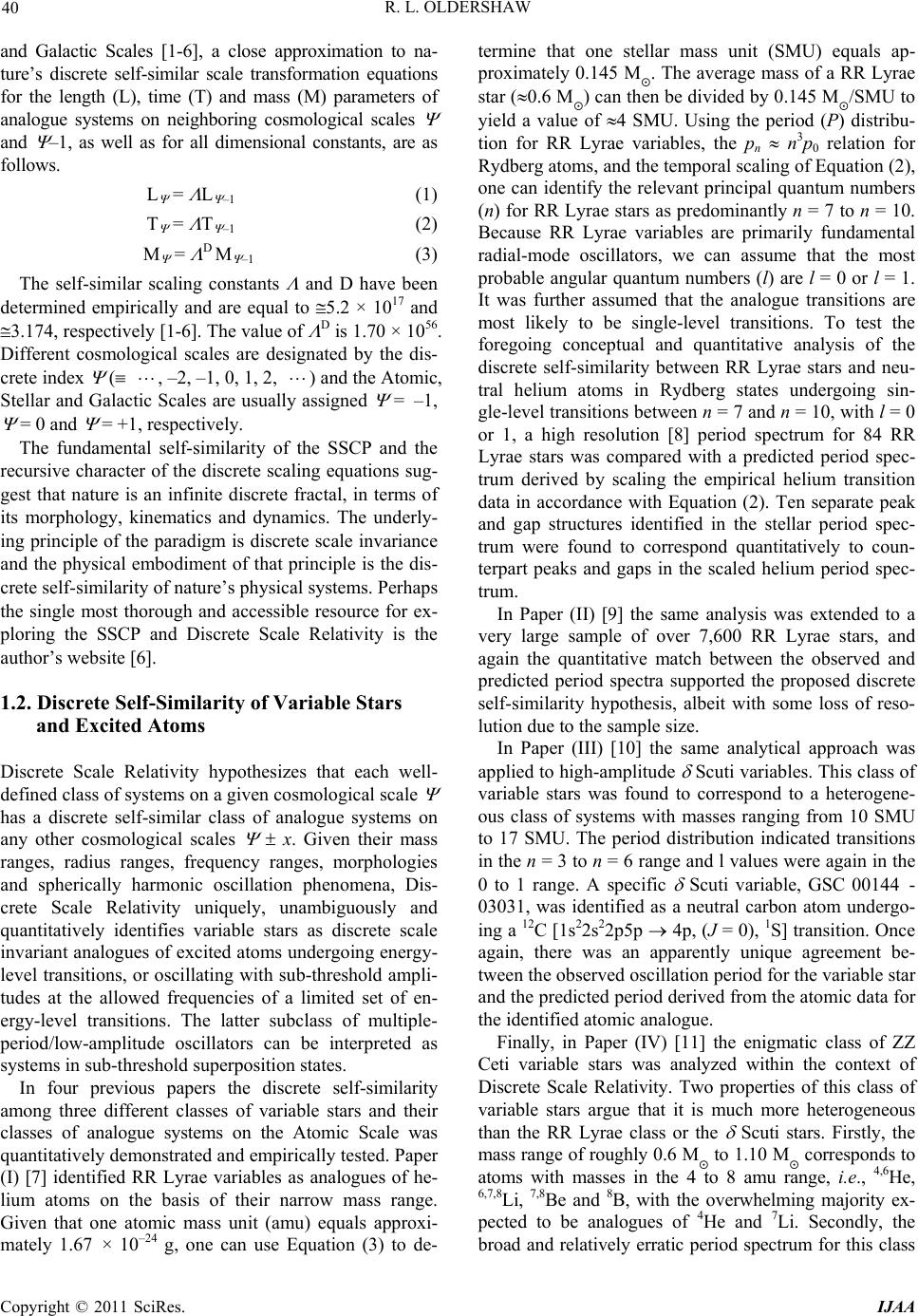
R. L. OLDERSHAW
40
and Galactic Scales [1-6], a close approximation to na-
ture’s discrete self-similar scale transformation equations
for the length (L), time (T) and mass (M) parameters of
analogue systems on neighboring cosmological scales
and
–1, as well as for all dimensional constants, are as
follows.
L
=
L
–1 (1)
T
=
T
–1 (2)
M
=
D M
–1 (3)
The self-similar scaling constants
and D have been
determined empirically and are equal to 5.2 × 1017 and
3.174, respectively [1-6]. The value of
D is 1.70 × 1056.
Different cosmological scales are designated by the dis-
crete index
( , –2, –1, 0, 1, 2, ) and the Atomic,
Stellar and Galactic Scales are usually assigned
= –1,
= 0 and
= +1, respectively.
The fundamental self-similarity of the SSCP and the
recursive character of the discrete scaling equations sug-
gest that nature is an infinite discrete fractal, in terms of
its morphology, kinematics and dynamics. The underly-
ing principle of the paradigm is discrete scale invariance
and the physical embodiment of that principle is the dis-
crete self-similarity of nature’s physical systems. Perhaps
the single most thorough and accessible resource for ex-
ploring the SSCP and Discrete Scale Relativity is the
author’s website [6].
1.2. Discrete Self-Similarity of Variable Stars
and Excited Atoms
Discrete Scale Relativity hypothesizes that each well-
defined class of systems on a given cosmological scale
has a discrete self-similar class of analogue systems on
any other cosmological scales
x. Given their mass
ranges, radius ranges, frequency ranges, morphologies
and spherically harmonic oscillation phenomena, Dis-
crete Scale Relativity uniquely, unambiguously and
quantitatively identifies variable stars as discrete scale
invariant analogues of excited atoms undergoing energy-
level transitions, or oscillating with sub-threshold ampli-
tudes at the allowed frequencies of a limited set of en-
ergy-level transitions. The latter subclass of multiple-
period/low-amplitude oscillators can be interpreted as
systems in sub-threshold superposition states.
In four previous papers the discrete self-similarity
among three different classes of variable stars and their
classes of analogue systems on the Atomic Scale was
quantitatively demonstrated and empirically tested. Paper
(I) [7] identified RR Lyrae variables as analogues of he-
lium atoms on the basis of their narrow mass range.
Given that one atomic mass unit (amu) equals approxi-
mately 1.67 × 10–24 g, one can use Equation (3) to de-
termine that one stellar mass unit (SMU) equals ap-
proximately 0.145 M. The average mass of a RR Lyrae
star (0.6 M) can then be divided by 0.145 M/SMU to
yield a value of 4 SMU. Using the period (P) distribu-
tion for RR Lyrae variables, the pn n3p0 relation for
Rydberg atoms, and the temporal scaling of Equation (2),
one can identify the relevant principal quantum numbers
(n) for RR Lyrae stars as predominantly n = 7 to n = 10.
Because RR Lyrae variables are primarily fundamental
radial-mode oscillators, we can assume that the most
probable angular quantum numbers (l) are l = 0 or l = 1.
It was further assumed that the analogue transitions are
most likely to be single-level transitions. To test the
foregoing conceptual and quantitative analysis of the
discrete self-similarity between RR Lyrae stars and neu-
tral helium atoms in Rydberg states undergoing sin-
gle-level transitions between n = 7 and n = 10, with l = 0
or 1, a high resolution [8] period spectrum for 84 RR
Lyrae stars was compared with a predicted period spec-
trum derived by scaling the empirical helium transition
data in accordance with Equation (2). Ten separate peak
and gap structures identified in the stellar period spec-
trum were found to correspond quantitatively to coun-
terpart peaks and gaps in the scaled helium period spec-
trum.
In Paper (II) [9] the same analysis was extended to a
very large sample of over 7,600 RR Lyrae stars, and
again the quantitative match between the observed and
predicted period spectra supported the proposed discrete
self-similarity hypothesis, albeit with some loss of reso-
lution due to the sample size.
In Paper (III) [10] the same analytical approach was
applied to high-amplitude
Scuti variables. This class of
variable stars was found to correspond to a heterogene-
ous class of systems with masses ranging from 10 SMU
to 17 SMU. The period distribution indicated transitions
in the n = 3 to n = 6 range and l values were again in the
0 to 1 range. A specific
Scuti variable, GSC 00144 -
03031, was identified as a neutral carbon atom undergo-
ing a 12C [1s22s22p5p 4p, (J = 0), 1S] transition. Once
again, there was an apparently unique agreement be-
tween the observed oscillation period for the variable star
and the predicted period derived from the atomic data for
the identified atomic analogue.
Finally, in Paper (IV) [11] the enigmatic class of ZZ
Ceti variable stars was analyzed within the context of
Discrete Scale Relativity. Two properties of this class of
variable stars argue that it is much more heterogeneous
than the RR Lyrae class or the
Scuti stars. Firstly, the
mass range of roughly 0.6 M to 1.10 M corresponds to
atoms with masses in the 4 to 8 amu range, i.e., 4,6He,
6,7,8Li, 7,8Be and 8B, with the overwhelming majority ex-
pected to be analogues of 4He and 7Li. Secondly, the
broad and relatively erratic period spectrum for this class
Copyright © 2011 SciRes. IJAA